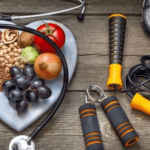In today’s fast-paced world, we often overlook the one thing that keeps us going — energy. Whether it’s working, studying, or just living your best life, your body needs fuel to keep the engine running. And I’m not talking about guzzling down those sugar-loaded energy drinks or grabbing a greasy burger on your lunch break (though, admit it, we’ve all been there!). This article is all about understanding how to properly fuel your body for a life full of energy, vitality, and perhaps fewer yawns during that dreaded afternoon slump.
Let’s dive into how you can transform your energy levels by making better choices for your body. No complex science here, just simple tips and tricks to help you energize your life!
What Does it Mean to ‘Fuel’ Your Body?
Let’s start with the basics: What does it actually mean to “fuel” your body? Just like a car needs gasoline (or electricity, if you’re fancy), your body needs the right kind of fuel to operate at its best. This fuel comes in the form of food and beverages, but not all fuel is created equal. Junk food might give you a temporary boost, but like putting low-quality gas in a car, it will leave you sputtering out before long.
The Good, the Bad, and the Ugly of Fueling
- The Good: Nutrient-rich foods like fruits, vegetables, whole grains, lean proteins, and healthy fats.
- The Bad: Processed foods, refined sugars, and saturated fats.
- The Ugly: Fast food, sugary sodas, and, let’s be honest, that third slice of pizza you probably didn’t need. (Yeah, we’ve all been there.)
Your body is like a finely tuned machine — it needs the right blend of carbs, proteins, and fats to keep things running smoothly. Think of your meals like a pit stop: the better the fuel, the better your performance.
Macronutrients: The Building Blocks of Energy
You may have heard the term “macros” thrown around by fitness buffs and nutritionists. They’re not some mystical health trend but the core nutrients your body needs to survive: carbohydrates, proteins, and fats.
Carbohydrates: The Quick Fuel
- What they do: Carbs are your body’s primary source of energy.
- Good sources: Whole grains, fruits, vegetables, and legumes.
- Avoid: Processed carbs like sugary snacks, pastries, and white bread. They’re like lighting a matchstick — they burn bright but fizzle out fast.
Proteins: The Repair Crew
- What they do: Proteins help repair tissues, build muscle, and keep your immune system running like a well-oiled machine.
- Good sources: Lean meats, poultry, fish, eggs, beans, and nuts.
- Avoid: Too many processed meats like hot dogs and bacon. Delicious, but your arteries might stage a protest.
Fats: The Long-Lasting Fuel
- What they do: Fats are essential for long-term energy storage and brain health.
- Good sources: Avocados, olive oil, nuts, seeds, and fatty fish like salmon.
- Avoid: Trans fats, found in fried foods and baked goods. They may taste heavenly, but your energy will crash faster than a bad Wi-Fi connection.
Micronutrients: Small but Mighty
Now that we’ve covered macros, let’s talk about micronutrients. These are the vitamins and minerals that keep your body running smoothly, much like the oil and coolant in your car.
Vitamins and Minerals You Shouldn’t Ignore
- Vitamin D: Supports bone health and immune function. Get it from sunlight (or supplements if you’re a vampire).
- Iron: Helps transport oxygen in the blood. Find it in red meat, beans, and spinach — and no, Popeye was not kidding!
- Magnesium: Vital for muscle and nerve function. You’ll find this mineral in leafy greens, nuts, and whole grains.
- Vitamin B12: Crucial for energy production. Animal products like meat, eggs, and dairy are good sources, but vegans may want to consider a supplement.
Table: Top Micronutrients and Where to Find Them
| Micronutrient | Best Sources | Benefits |
|---|---|---|
| Vitamin D | Sunlight, fish, egg yolks | Bone health, immune support |
| Iron | Red meat, beans, spinach | Oxygen transport in the body |
| Magnesium | Leafy greens, nuts, whole grains | Muscle and nerve function |
| Vitamin B12 | Meat, dairy, eggs | Energy production, nerve health |
Hydration: The Unsung Hero of Energy
We all know that drinking water is important, but it’s often overlooked in the quest for more energy. Here’s a not-so-fun fact: by the time you feel thirsty, you’re already dehydrated. And dehydration can make you feel tired, cranky, and downright miserable.
How Much Water Do You Really Need?
The typical recommendation is to drink about 8 cups of water a day, but this can vary depending on factors like your activity level, climate, and whether or not you enjoy long conversations with your houseplants. (No judgment.)
If plain water isn’t your thing, try jazzing it up with a slice of lemon, cucumber, or even a sprig of mint. Staying hydrated doesn’t have to be boring!
Sleep: The Best Energy Booster You’re Not Using Enough
Food is a key player in energy production, but let’s not forget about the ultimate energy hack: sleep. Yes, that thing we all crave but often skimp on. No amount of kale or quinoa will replace the power of a good night’s sleep.
Why Sleep Matters
When you sleep, your body is doing more than just lying there like a log. It’s repairing cells, regenerating tissues, and basically recharging your internal battery. Without enough sleep, it doesn’t matter how much broccoli you eat — you’re going to feel like a zombie.
Tips for Better Sleep
- Stick to a Schedule: Try to go to bed and wake up at the same time every day, even on weekends. (Yes, this means giving up that Saturday sleep-in…)
- Create a Bedtime Ritual: Reading, meditating, or listening to calming music can help signal to your body that it’s time to wind down.
- Limit Caffeine and Sugar: Consuming these late in the day can mess with your sleep cycle. But let’s be real: that 4 PM coffee might feel worth it at the time.
Exercise: Fueling Your Body Beyond Food
You don’t need to be a gym rat to understand that exercise is crucial for maintaining energy levels. When you move your body, you increase your circulation, boost your mood, and improve your overall stamina.
The Power of Movement
Even something as simple as a brisk walk or a quick yoga session can revitalize you. The goal is to get your blood flowing and those endorphins (your body’s natural feel-good chemicals) pumping.
Exercise and Energy: A Symbiotic Relationship
Ironically, exercising can make you feel more energized, even though you’re expending energy. Regular physical activity increases your body’s efficiency at using oxygen, meaning less effort is required to do the same tasks.
Types of Exercises to Energize Your Life
- Cardio: Walking, jogging, cycling, or swimming — all are great for boosting your heart health and stamina.
- Strength Training: Lifting weights or doing bodyweight exercises can build muscle and improve your metabolism.
- Stretching: Don’t skip this! Stretching helps reduce stiffness and improve flexibility, making you feel less like the Tin Man after a workout.
Avoiding the Energy Vampires
No, I’m not talking about avoiding your overly dramatic friend who thrives on emotional drama (although that might help too!). Energy vampires come in many forms — they’re the sneaky habits or foods that drain your energy without you even realizing it.
Energy Vampires to Watch Out For
- Skipping Meals: This seems like an easy way to save time, but you’re really just setting yourself up for an energy crash. Keep healthy snacks handy to avoid this pitfall.
- Too Much Screen Time: Staring at screens for hours on end can lead to digital eye strain, which leaves you feeling drained. Try taking regular breaks (cue the famous 20-20-20 rule: look at something 20 feet away for 20 seconds every 20 minutes).
- Stress: It’s an energy thief. Learning to manage stress through mindfulness, exercise, or deep breathing can help keep it from draining you.
Your Personalized Energy Plan
Everyone’s body is different, which means your personal energy-boosting plan might not look the same as your neighbor’s. Here’s a simple template to help you create a balanced approach to fuel your body and energize your life.
Daily Energy Plan
| Time | Activity | Why it Helps |
|---|---|---|
| Morning (7-9 AM) | Healthy breakfast with protein and fiber | Jumpstarts your metabolism and provides lasting energy |
| Mid-morning (10-11 AM) | Stretch or quick walk | Increases circulation and keeps your energy steady |
| Lunch (12-1 PM) | Balanced meal with carbs, protein, and fats | Refuels your body for the rest of the day |
| Afternoon (2-3 PM) | Snack with fruit or nuts | Prevents the afternoon slump |
| Evening (5-6 PM) | Light exercise or walk | Relieves stress and boosts endorphins |
| Night (9-10 PM) | Wind down with calming activities | Prepares your body for a restful sleep |
Conclusion: Energize Your Life
In conclusion, fueling your body is about more than just eating the right foods (though that’s definitely part of it!). It’s about creating a lifestyle that supports your energy needs, from proper nutrition and hydration to exercise and quality sleep.
Remember, it’s not about being perfect. No one expects you to never eat a cookie again or suddenly become a marathon runner overnight. It’s about making small, sustainable changes that add up to big energy gains over time. So go ahead, fuel your body, energize your life, and maybe skip that third slice of pizza (just this once!).




